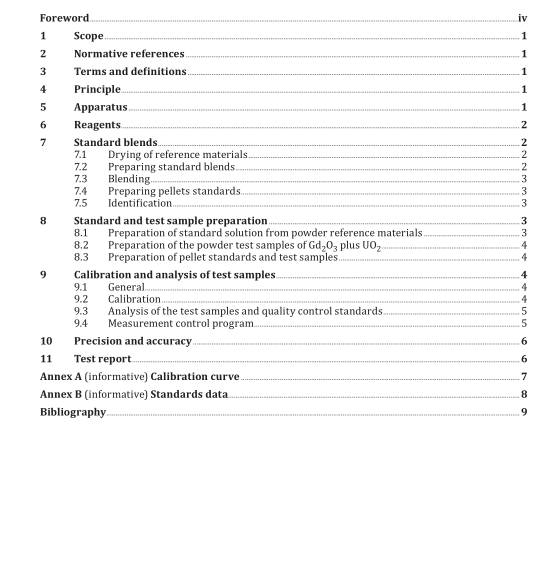ISO 16796:2022 pdf download.Nuclear energy — Determination of Gd 2 O 3 content in gadolinium fuel blends and gadolinium fuel pellets by atomic emission spectrometry using an inductively coupled plasma source (ICP-AES)
This document is applicable to the determination of gadolinium as Gd 2 O 3 in powder blends and sintered pellets of Gd 2 O 3 + UO 2 and ((U, Gd) O 2 ) from mass fraction 10 g/kg to 100 g/kg (i.e. 1 % to 10 %), using a suitable ICP-AES instrument.
This methodology is capable of demonstrating compliance with agreed upon fuel specifications and associated data quality objectives provided the user has performed qualification measurements under their established measurement control program to demonstrate that measurement uncertainty requirements will be met with the desired level of confidence at the specification.
2 Normative references
The following documents are referred to in the text in such a way that some or all of their content constitutes requirements of this document. For dated references, only the edition cited applies. For undated references, the latest edition of the referenced document (including any amendments) applies.
ISO 3696, Water for analytical laboratory use — Specification and test methods
3 Terms and definitions
No terms and definitions are listed in this document.
ISO and IEC maintain terminological databases for use in standardization at the following addresses:
— ISO Online browsing platform: available at https:// www .iso .org/ obp
— IEC Electropedia: available at https:// www .electropedia .org/
4 Principle
The test sample is weighed and dissolved in nitric acid. The test sample solutions are aspirated into an inductively coupled plasma using argon as a carrier. The emitted light from the test sample in the plasma is dispersed, and the gadolinium line at 335,0 nm is measured by a spectrometer.
The intensity of the gadolinium line is proportional to the concentration of gadolinium present.
Impurity interferences have not been observed for the usual test samples of the nuclear grade material.
5 Apparatus
5.1 Inductively coupled plasma atomic emission spectrometer (ICP-AES). A typical value for resolution is 0,555 nm/mm in the first order.
5.2 Analytical balance; sensitivity ±0,1 mg.
5.3 Three-dimensional shaker mixer.
5.4 Hot plate.
5.5 Micropipettes; accurate to ±0,25 %.
5.6? Volumetric? flasks; accurate to ±0,25 %.
5.7 Glass beakers.
5.8 Percussion mortar.
5.9 Pellet press.
5.10 Muffle furnace.
6 Reagents
6.1 Concentrated nitric acid, analytical reagent grade.
6.2 Demineralized water, in accordance with the Grade 2 purity requirements of ISO 3696.
6.3 Nitric acid, 1:1, prepare by diluting equal volumes of concentrated nitric acid and demineralized water.
6.4 Uranium dioxide, nuclear grade reference material, obtained from a qualified supplier.
6.5 Gadolinium oxide, Gd 2 O 3 , minimum mass fraction 999,9 g/kg, reference material, obtained from a qualified supplier.
7 Standard blends
Standard powder blends are prepared under laboratory conditions from the UO 2 and Gd 2 O 3 high-purity reference materials listed in Clause 6. These standards will contain Gd 2 O 3 mass fraction in the range of 10 g/kg to 100 g/kg, depending on the anticipated Gd 2 O 3 content in the test samples.
Guidance on preparing working reference materials is available in ASTM C1128 [3] .
7.1 Drying of reference materials
The UO 2 and Gd 2 O 3 powders are dried at 110 °C for 2 h and allowed to cool in a desiccator (or dried and cooled as directed by the reference material supplier) before preparing the standard blends.
7.2 Preparing standard blends
The appropriate amounts of Gd 2 O 3 and UO 2 are weighed on an analytical balance into different plastic vials to obtain the standard blends containing Gd 2 O 3 mass fraction in the range from 10 g/kg to 100 g/ kg.
7.3 Blending Each blend is mixed in the three-dimensional shaker mixer for 4 h (or the time necessary to guarantee the homogeneity of the blend).
7.4 Preparing pellets standards After blending, the powders are pressed into pellets. Care shall be taken to clean the press before pressing the standard pellets. The first set of pressed pellets for each Gd 2 O 3 mass fraction shall be discarded. As sintering conditions may strongly impact the analytical results, sintering of the pellet standards shall be performed under the same conditions as production. The Gd 2 O 3 content of the standard pellets shall be validated, using the procedure described in this document, before being used for calibration or quality control.ISO 16796 pdf download.ISO 16796 pdf download
